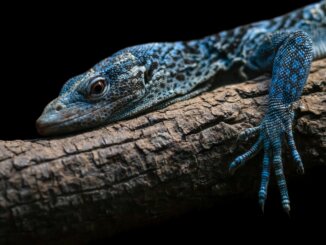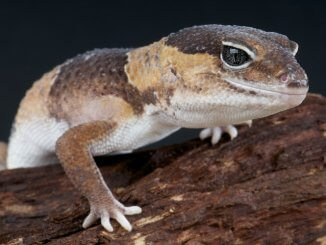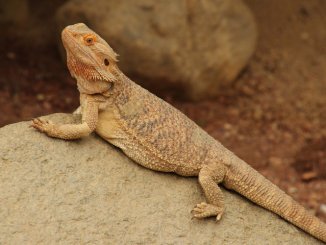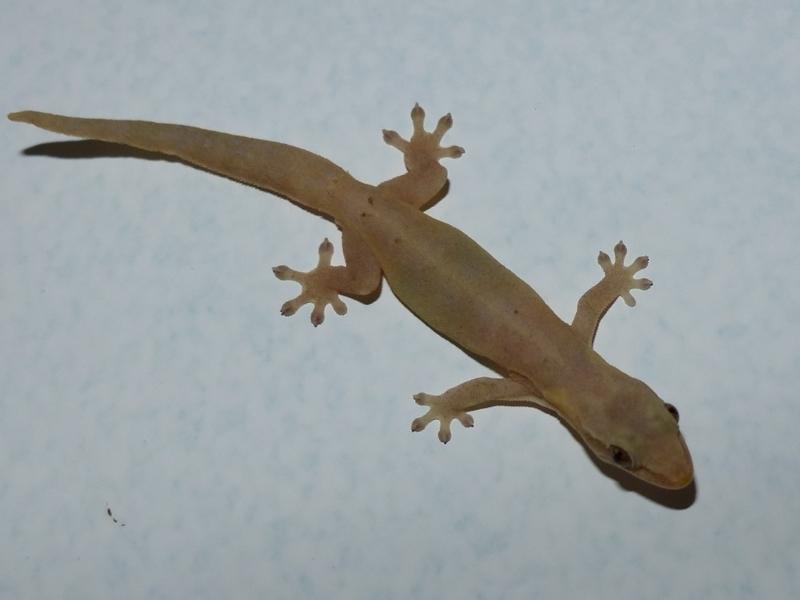
The mourning gecko is a small lizard species hailing from regions in Central America, South America, the South Pacific, and Hawaii.
This species is easy to breed and care for. Many people keep mourning geckos as feeders for snakes because the lizards breed so readily.
Mourning Gecko Overview
| Common name | Mourning gecko, smooth scaled gecko, maritime gecko, sad gecko |
| Scientific name | Lepidodactylus lugubris |
| Natural habitat | Tropical coastal areas in Central America, South America, the South Pacific, and Hawaii |
| Adult size | 3.5–4 inches |
| Average lifespan | 10–15 years |
| Diet | Omnivore |
| Housing | Minimum 10 gallons, 65–85°F, 60%–85% humidity |
| Experience | Beginner |
Origin
The mourning gecko originates in the tropical and semi-tropical coastal areas of the Indian and Pacific Oceans. The lizards are distributed widely across Thailand, Sri Lanka, The Maldives, Fiji, Myanmar, the Philippines, Indonesia, Western Samoa, Japan, Vietnam, and many other regions in Central America, South America, the South Pacific, and Hawaii.
Mourning geckos are cathemeral, meaning that they’re active periodically throughout the day and night in the wild. At night, the lizards eat, hunt, breed, and socialize in groups. Rainforests, deserts, and plantations are common natural habitats for mourning geckos.
Appearance and Behavior
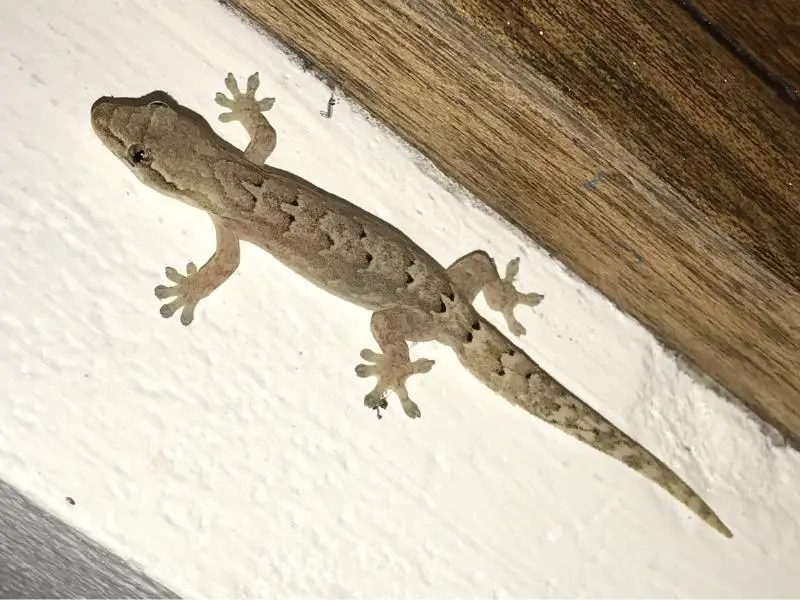
The mourning gecko has a small, slim body in shades of brown to light tan. The lizard has a light cream belly, a stripe from each ear to the nostril, and a dark zigzag pattern on its back.
Mourning geckos have long, thick tails used for fat storage, pointed noses, and round, slightly protruding eyes with no eyelids. The lizards have smooth skin on their backs, giving them the common name, “smooth scaled gecko.”
The majority of mourning geckos are females because the lizards clone themselves and don’t need males to reproduce. While some male mourning geckos exist, they’re rarely found and are often sterile.
Size and Lifespan
The average length of a mourning gecko is 3.5–4 inches from nose to tail. The lizards grow slowly and reach full size by 8–10 months old.
Most mourning geckos live for between 10 and 15 years with proper care.
Temperament
The mourning gecko is a sociable but skittish lizard that feels most comfortable in a large group of other mourning geckos. This lizard is peaceful and friendly, and becomes vocal and playful when housed in small communities.
Mourning geckos squeak and croak to communicate with one another. The lizards have irregular patterns of activity throughout the day and night, but they tend to be most active at night. The majority of mourning geckos in captivity are female, so fighting and territorial behavior amongst the lizards is rare and not a concern. Mourning geckos tolerate brief handling but prefer to be left alone.
Housing Mourning Geckos
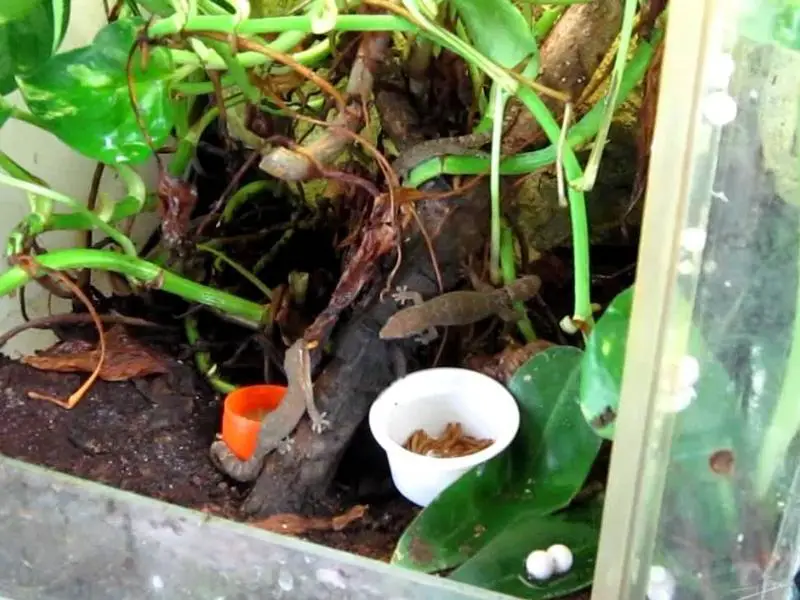
The mourning gecko’s natural habitat is hot, humid forests, deserts, and plantations in tropical regions around the world. Replicate the lizard’s environment as closely as possible in captivity to ensure the lizard is comfortable in its surroundings.
Keep mourning geckos in a tall, front-opening glass gecko terrarium or vivarium.
Enclosure size
The ideal enclosure size for a mourning gecko is at least 10 gallons. The lizard enjoys climbing, so the enclosure should be at least 18 inches tall. The tank’s width and depth should both be at least 12 inches.
Lighting
Mourning gecko enclosures with artificial plants don’t require tank lighting as long as the enclosure is located in a room with a window. Ensure the enclosure gets at least eight hours of sunlight per day so that the lizard can differentiate between day and night. If you have a bioactive tank setup, install an LED light in the enclosure to encourage plant growth.
The necessity of UV light in a mourning gecko enclosure is widely debated. Emerging evidence suggests that even semi-nocturnal species benefit from UVB light. Install a low-percentage UV bulb, such as a 6% bulb, at least 10 inches above the lizard’s highest access point in the enclosure.
Temperature and Humidity
Mourning geckos have different temperature preferences for different times of the day. During the daytime, maintain a temperature of 70–80°F in the enclosure. At night, allow temperatures to fall as low as 65°F. Invest in a heater if you can’t sustain these temperatures throughout the year.
Provide a basking area with a warmer temperature of 85°F on a tall climbing spot in the enclosure. Mourning geckos thermoregulate (control their body temperature) by moving from hot spots to cooler spots, so offering a temperature gradient in the tank should keep the lizards comfortable. Use a thermometer to measure temperatures in your enclosure and ensure they remain consistent.
The ideal humidity for a mourning gecko enclosure is between 60% and 85%. If humidity drops below 60%, mist the enclosure with tap water or install an automatic mister. Use a hygrometer to monitor humidity.
Substrate and Decoration
Choose an absorbent substrate for your enclosure. Good substrate choices for mourning geckos are sphagnum moss, coconut coir, and reptile-safe soil (which is the best option if you plan to use live plants in the space).
Mourning geckos thrive in a bioactive enclosure, which combines living elements that work together in a miniature ecosystem. To create a bioactive enclosure, place a layer of drainage balls at the bottom of the tank, followed by a layer of substrate mesh, then your chosen substrate (populated with insects like woodlice and springtails). Plant humidity-loving plants, like bromeliads, in the substrate.
Provide plenty of opportunities for climbing in the enclosure with leafy bushes, cork branches, climbing platforms, shade plants, and vines. Live and artificial plants create a network of climbing paths and offer coverage, which should encourage the lizard to be active in the enclosure.
Decorating the enclosure with plenty of vegetation and branches should give the space a natural feel and ensure mourning geckos feel happy and at home in their captive environment.
Cleaning
Spot-clean your mourning gecko’s enclosure at least once a day. Replace soiled substrate and wash out the water bowl to avoid bacteria buildup.
Deep-clean the enclosure every four weeks. Remove all the decorations from the enclosure and tip away the substrate. Clean the walls, base, and lid of the enclosure with reptile-safe sanitizers. Soak the decorations in warm water. Wipe the leaves of live plants with a cloth dipped in warm water. Place the mourning gecko in a temporary enclosure during cleaning. Use equal parts white vinegar and water to clean tough stains.
Once you’re done, add a fresh layer of substrate to the enclosure and return the plants and decorations.
A bioactive gecko enclosure requires less frequent cleaning because the insects spend most of their time cleaning the substrate.
Mourning Gecko Care
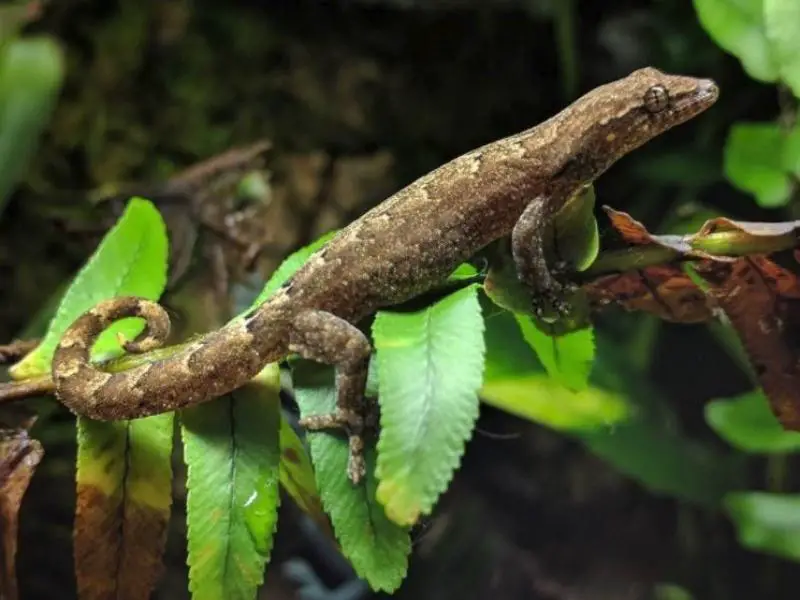
Mourning geckos are easy to feed, breed, and look after in captivity.
Food and Water
In the wild, mourning geckos eat an omnivorous diet of insects, flower nectar, isopods, and fruit. Provide a similar diet in captivity to ensure the lizards are healthy and well-fed in your care. Feed the mourning gecko a combination of powdered fruit mix, flightless fruit flies, pinhead crickets, and small roaches. Ensure the insects are gut-loaded to increase their nutritional value.
Provide your lizard with a plentiful source of calcium by dusting your feeder insects with a reptile-safe powdered calcium supplement. If you don’t use UVB in your enclosure, add vitamin D supplements to your mourning gecko’s diet.
Mourning geckos eat crickets in the wild, but you shouldn’t feed the lizards crickets in captivity because the crickets could grow too large to be safely digested.
The best feeding schedule for a mourning gecko is protein-based foods three times a week and plant-based foods twice a week. Fast the lizard for the remaining two days to allow for healthy digestion.
This lizard species should have constant access to clean water. Place a water bowl in a shaded section of the enclosure and add fresh water daily.
Handling
Mourning geckos are small and easy to handle when necessary, but these lizards are quick movers and aren’t known to sit still. When you pick up a mourning gecko, it’ll likely dart out of your hand and disappear from view.
To avoid spending hours searching for your lizard on the floor, only handle mourning geckos for a purpose, such as for health inspections and tank cleaning. The lizards are best enjoyed through observation.
Common Health Issues
Mourning geckos are prone to several of the most common health issues faced by reptiles in captivity. Most of these infections are caused by poor living conditions.
Respiratory Infections
Respiratory infections are caused by bacteria, fungi, viruses, or parasites. Symptoms of a respiratory infection include wheezing, discharge from the nose and eyes, shallow or open-mouthed breathing, and lethargy. Treat the infection with antibiotics or other medications depending on the infection’s source. Reduce the risk of a respiratory infection by maintaining a clean enclosure and an optimal temperature gradient.
Metabolic Bone Disease
Metabolic bone disease occurs when a mourning gecko is deficient in vitamin D3 or calcium. The disease causes lethargy, a kinked or crooked tail, seizures, curved limbs, and loss of appetite. To treat metabolic bone disease, add calcium supplements to your lizard’s foods and install a UVB light in an area that the lizard frequents regularly, such as the basking area.
Shedding Problems
Mourning geckos shed regularly as they grow as adults. If the humidity in the enclosure is too low, shedding problems are likely to occur. Prevent shedding problems by maintaining at least 70% humidity. To treat a gecko that is struggling to shed, place the lizard in a bath of mildly warm water to loosen up the old skin so that it can come off easier. Provide plenty of rough surfaces in the enclosure for the lizard to rub against to remove old skin.
Breeding
In the wild, female mourning geckos “breed” in a process called parthenogenesis, a reproductive strategy that enables the lizards to develop eggs without fertilization. The lizards reach sexual maturity at about nine months old. All mourning gecko babies are clones of their mother.
Breeding mourning geckos at home is easy, and is possible with only one lizard. There’s no special setup required for a mourning gecko to reproduce — a healthy adult female should lay two eggs every four to five weeks without your input.
You should find mourning gecko eggs clustered on a log or stuck to the enclosure walls, near the top of the enclosure, where the temperature is warmest. The eggs will incubate naturally and hatch within two months.
Move the babies into a separate enclosure to prevent the parents from eating them. Feed the babies chopped-up fruit flies and powdered fruit mix until they’re large enough to be moved back into the home enclosure (usually within four to six months).
Choosing and Buying a Mourning Gecko
The average cost of a mourning gecko is about $22. Because mourning geckos are easy to breed, the lizards are widely for sale in pet stores and online. Many sellers offer discounted rates for people looking to buy multiple mourning geckos at once. Some sellers offer starter kits, including a small enclosure, decorations, and a group of mourning geckos, for around $100.
When choosing a mourning gecko to buy, ask to see the lizard (preferably in person, otherwise in pictures and videos), before you buy it. Check that the lizard has smooth skin with no lumps and bumps, and bright, clear eyes. Don’t buy lizards with deformed or twisted features, external parasites, discharge from the eyes or nose, and wheezing or trouble breathing.

